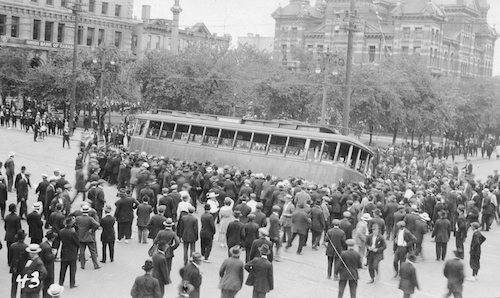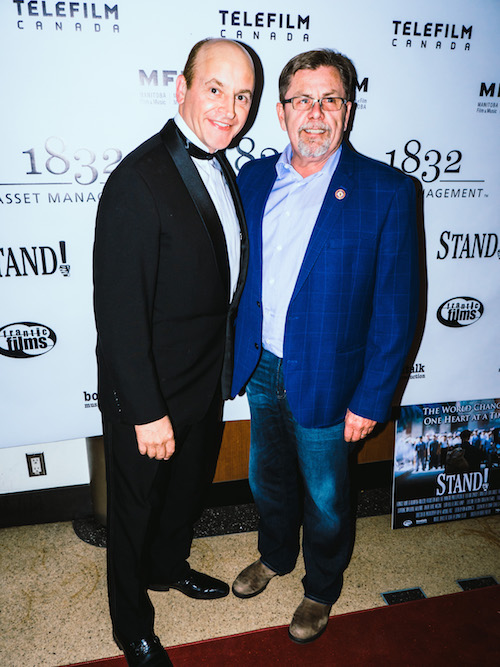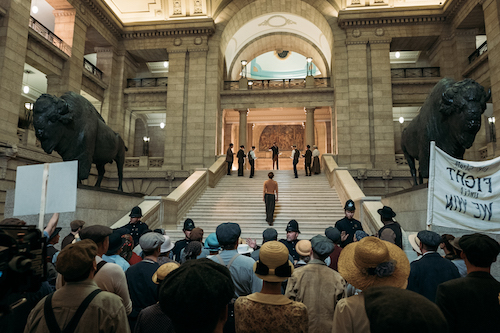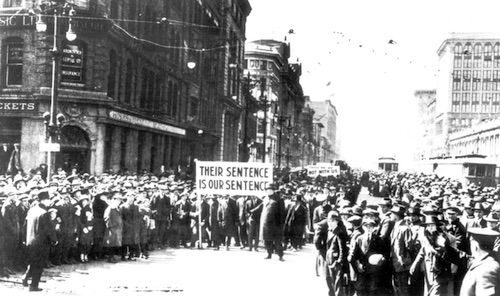“What if you could get ninety dollars in six months?”
“Quit dreaming, there’s no union here.”

|
| What began as a silent march turned violent when strikers were assaulted by untrained special police – men deputized and armed with clubs after much of Winnipeg’s police force was fired for supporting the workers. Under attack, as seen in this historic photo, strikers pushed a streetcar off its tracks on what became known as “Bloody Saturday,” June 21, 1919. Marking the strike’s centennial last year, the city erected a full-size steel sculpture of the streetcar, half-tilted, as it appears above.
|
Rage, misery, passion and purpose were building to a crescendo in 1919 Winnipeg.
The capital of Manitoba, then Canada’s third-largest city, was combustible: poverty-level wages, injustice, dismal and dangerous working conditions, mass unemployment, soaring inflation, even starvation — desperation met with customary contempt from the rich and powerful.
All the ingredients a city needed for a historic uprising. And all the drama moviemakers could ask for a century later telling the story of the landmark Winnipeg General Strike on the big screen in “Stand!”
“The strike was a monumental turning point in Canadian labor history,” said Tom Reid, international vice president for IBEW Canada. “It unified workers and laid the foundation for life-changing labor reforms, the growth of unions and collective bargaining.’
Canadian IBEW members were among the first to see “Stand!” when the musical — songs, no dance — premiered during the Toronto International Film Festival last year, the strike’s centennial.
Now it’s Americans’ turn with a special one-night premiere of the movie Dec. 1 in theaters nationwide, arranged by screenwriter, composer and co-producer Danny Schur.
(Update: As of May 1, “Stand!” will be available On Demand in the United States and Canada.From Friday, March 19 to Sunday April 4, an IBEW-exclusive edition is being offered to U.S. members at the discounted price of $7.99, allowing 72 hours of unlimited streaming.)
The century-old event tells a universal workers’ story that he believes will resonate with American union members and the greater U.S. audience. His excitement grows each time he talks to unions across the country that are planning safe, socially distanced watch parties.
“It’s a labor story from a time with so many equivalents to the present,” Schur said. “You can watch “Stand!” to see how far we’ve come, but also how far we have to go.”
IBEW Canada leaders, who donated tickets to university students and young-worker committees for the Toronto premiere, say the movie has an especially valuable message for today’s generation.

|
| Screenwriter, composer and co-producer Danny Schur, left, with IBEW Canada International Vice President Tom Reid at “Stand!” premiere during Toronto International Film Festival in 2019.
|
“It’s really a lesson I think young workers need, whether Canadian or American — seeing what generations of workers before us had to fight for, what they were up against, why they decided to walk out and withhold their service,” said Matt Wayland, First District international representative.
“I’m not a musical guy,” he added, “and I loved the movie.”
ON MAY 15, 1919 more than 30,000 men and women, union and non-union, private sector and public walked off the job in Winnipeg, one-sixth of the city’s population.
They were factory and trade workers; dressmakers and household servants; transportation and postal workers; linemen and telephone operators whose successors one day would be IBEW members.
In fact, operators jumpstarted the citywide strike, which came on the heels of walkouts by tradesmen after contract talks broke down.
As immortalized by a banner headline in the morning paper on May 15, the strike was set to start at 11 a.m. But hundreds of “hello girls,” as they were called, didn’t show up for their 7 a.m. shifts, leaving the city without telephone service.
By afternoon, a block-letter headline screamed, “67 Labor Unions Join in General Walk-Out; Industry Paralyzed.”
Winnipeg’s powerbrokers rapidly formed a “Citizens’ Committee” to oppose the strike. They began printing their own newspaper to tar strike leaders and incite fear, declaring the walkout a criminal conspiracy led by "alien scum” trying to overthrow democracy.
The strike came to a bloody end after six weeks on a June Saturday as workers staged a peaceful, powerfully silent march. It was crushed by brutal “special police” armed with clubs, enforcers deputized after the city fired most of its actual police force for refusing to sign a loyalty pledge.
In the aftermath, two strikers lay dead and scores were jailed. A dozen spent up to two years in federal prison.
But revolutions aren’t won, or lost, overnight. The labor movement was energized, buoyed by public support. Several strike leaders were elected to the Manitoba Legislature, another became Winnipeg’s mayor and two eventually served in Parliament.
Their success planted the seeds for what became Canada’s New Democratic Party, which plays a vital role today in the nation’s coalition government under Prime Minister Justin Trudeau.
The Winnipeg General Strike, one of its historians said, turned out to be “the most dramatic event in Canadian labour history.”
ITS STORY originated as a stage musical called “Strike!” that Schur premiered in 2005. It’s been performed continually since in theaters across Canada.
To call his opus a labor of love is no cliché.
He pays homage to workers’ rights, social justice, women’s rights, the power of solidarity, and the gifts and grief of sacrifice. Behind the scenes, he ensured the production — filmed entirely in Winnipeg — was “as union as union gets.”

|
|
Actress Haley Sales as legendary union leader Helen Armstrong, in a scene set in the Manitoba Legislative Building in Winnipeg. “Stand!” was produced with an all-union cast and crew.
|
It’s also a personal story.
Schur’s grandparents, Ukrainian Catholics, settled in rural Manitoba near the turn of the 20th century. They were among millions of immigrants to North America fleeing upheaval, poverty, and persecution in pre-war Europe.
A generation later, his trailblazing Aunt Jean married into a Jewish family, an interfaith relationship scorned by some of Schur’s relatives. The story’s fiery Jewish suffragette and her tumultuous romance with a penniless Catholic immigrant from Ukraine were inspired by Jean and her real-life love story. Schur just reversed their faiths.
“Stand!” celebrates strong women of the place and times who played leading roles in the strike and other progressive battles. It’s a point of fact, not political correctness. Women in Manitoba won the right to vote in 1916 — the first in Canada and three years ahead of the United States.
“Women were superstars in the progressive movement long before Norma Rae,” Schur said. “The 1920s make the 70s look like the 50s.”
THE SOLIDARITY in 1919 Winnipeg was in pursuit of rights and freedoms that workers and social justice allies in the United States and around the world are fighting to save today.
“Stand!” reflects the good, the bad, and the ugly — then and now.
In a shameful chapter of Canada’s history in the years leading to the strike, more than 8,500 Eastern Europeans were unjustly declared “enemy aliens” and held in prison camps during World War I.

|
|
In this original 1919 photo, workers march to protest the imprisonment of strike leaders, who were among dozens arrested when “special police” brought the walkout to a bloody end after six weeks.
|
Distrust and bigotry plagued foreigners, no matter their status. Tensions boiled over as soldiers returned after the war
As the movie depicts, a perfect storm was brewing in Winnipeg in spring 1919. Inflation and unemployment soared as war-weary soldiers returned home to find desperate immigrants filling their jobs under six-month contracts that amounted to pennies an hour.
Characters in “Stand!” lyrically yearn for just $10 more for a half-year’s work. Women working in garment shops and household staff sing of $50 growing to $60. Men, filthy and sweaty from backbreaking work in a pumphouse, long for $80 to become $90.
They seem unaware that a living wage for a small family in Winnipeg at the time would have required 10 times their income, Schur said.
The resulting turmoil wasn’t unique to Winnipeg. People were struggling and suffering across North America. Survival meant standing together and fighting back.
While Canadian workers benefit today from the strong voice of the NDP and the federal Liberal Party, they aren’t immune to assaults on their rights. They fear things could get worse, and watch the attacks on rights, freedoms, and economic security in the United States with grave concern.
Schur wants to entertain American audiences with “Stand!” but he and IBEW leaders also hope they’ll be motivated by it.
“The aristocracy now are doing the same things they did back then,” said Winnipeg Local 2085 Business Manager Russ Shewchuk, a fan of the stage show and movie. “I think IBEW members will draw some similarities from the movie. History is repeating itself right in front of your own eyes.”